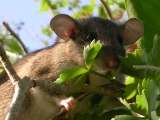Eastern woodrat
| Eastern woodrat | |
|---|---|
 | |
| Neotoma floridana smalli | |
| Scientific classification | |
| Kingdom: | Animalia |
| Phylum: | Chordata |
| Class: | Mammalia |
| Order: | Rodentia |
| Family: | Cricetidae |
| Genus: | Neotoma |
| Species: | N. floridana |
| Binomial name | |
| Neotoma floridana (Ord, 1818) | |
The eastern woodrat (Neotoma floridana), also known as the Florida woodrat or bush rat is a pack rat native to the central and Eastern United States.
Taxonomy
The eastern woodrat was previously considered conspecific with the Allegheny woodrat but is now considered a separate species.[1]
Description
The eastern woodrat is a rodent of medium size and is covered in a soft, gray-brown pelage. Sexes are alike, but males tend to be slightly larger.[2]
Distribution and habitat
The general distribution of the eastern woodrat ranges latitudinally from central Florida to southeastern New York, and longitudinally from Connecticut to eastern Colorado.[2] Reintroduction to north-eastern states such as Illinois have occurred in the 2010s.[3] The species has been recovered as a fossil from late Pleistocene deposits in southeastern New Mexico, several hundred miles southwest of its nearest current range.[4]
The species inhabits wooded areas, swamps and hedges, with a variety of different habitat preferences reported for the recognized geographic subspecies.[1]
Ecology
As with most members of the genus, the eastern woodrat feeds opportunistically on nuts, seeds, fungi, buds, stems, roots, foliage, and fruits.[1] While the eastern woodrat's nest is typically found on the ground, it is a capable climber and may forage above ground.[2] The species is solitary except during breeding season.[2] It is nocturnal and thus does most of its foraging at night.[5]
Nests are built of sticks, debris, and various plant materials, depending on habitat. They are re-used over multiple years and may become quite large. Nests have been found to provide habitat for a number of other species including rabbits, mice, snakes, amphibians, and various invertebrates.[1] The species does not hibernate, even in the northern extremes of its range.[5] The breeding season tends to be long, and ranges from March–October in Oklahoma to all year in Florida. Litters are comparatively small (2-4 young), but there may be up to three litters per year.[1]
Predators of the eastern woodrat include the black rat snake and long-tailed weasel.[1]
References
- 1 2 3 4 5 6 7 Linzey, A.V.; NatureServe; Jordan, R.A. & Hammerson, G. (2008). "Neotoma floridana". IUCN Red List of Threatened Species. IUCN. 2008: e.T42650A10740600. Retrieved 16 November 2016.
- 1 2 3 4 Wiley, R. (1980). "Neotoma floridana" (PDF). Mammalian Species. 139: 1–7.
- ↑ Poole, A. K.; Novosak, B. A.; Gooley, A. C.; Ing, D. M.; Bluett, R. D.; Carter, T. C.; Feldhamer, G. A. (2013). "Reintroduction of the eastern woodrat (Neotoma floridana) in southern Illinois". Southeastern Naturalist. 12 (1): 1–10.
- ↑ Harris, A. H. (1984). "Neotoma in the Late Pleistocene of New Mexico and Chihuahua". Special Publications of the Carnegie Museum of Natural History. 8: 164–178.
- 1 2 Rossell Jr, C. R.; Roach, S. H.; Rossell, I. M.; McGrath, C. (2009). "Attributes of rock crevices selected by Allegheny and eastern woodrats in the zone of contact in the Appalachian mountains of North Carolina". American Midland Naturalist. 162 (1): 200–206.
- Monty, Anne-Marie & Emerson, Robert E. (2003). "Eastern Woodrat". In Feldhamer, George A.; et al. Wild mammals of North America: biology, management, and conservation. JHU Press. ISBN 978-0-8018-7416-1.
